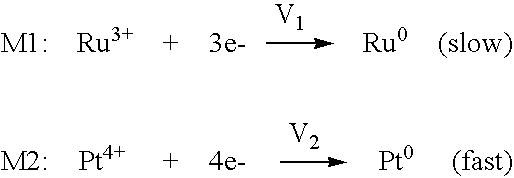Method for manufacture of noble metal alloy catalysts and catalysts prepared therewith
a noble metal alloy and catalyst technology, applied in the direction of catalyst activation/preparation, metal/metal-oxide/metal-hydroxide catalysts, chemical/physical processes, etc., can solve the problem of low degree of alloying, incomplete ptru alloy formation, and very sensitive platinum anode catalysts to poisoning by carbon monoxide. , to achieve the effect of high degree of alloying
- Summary
- Abstract
- Description
- Claims
- Application Information
AI Technical Summary
Benefits of technology
Problems solved by technology
Method used
Image
Examples
example 1
50 wt % PtRu / C Alloy Catalyst
[0052] 12.0 g Ru(III)-chloride (aqueous solution with 20 wt. % Ru; Umicore, Hanau / Germany) were taken in 500 ml 1,2-propylene glycol (PG) in a reaction flask. After stirring for 30 min at 300 rpm, conc. NaOH solution was added to obtain the desired pH value of 5.5.
[0053] In the next step, 1.75 g arabic gum (Merck AG; Darmstadt / Germany, previously dissolved in 10 ml of water under mixing) were added to the above reaction mixture by rinsing the beaker with 50 ml polyol. After 30 min mixing, 7.0 g carbon black Vulcan XC 72R (Cabot Corp., Billerica, Ma. / USA) was added to the mixture. After 1 hour of mixing, the content of the flask was heated up to 150° C.
[0054] After the mixture has adjusted to this temperature, the Pt precursor was added. 18.4 g chloroplatinic acid (H2PtCl6, aqueous solution with 25 wt. % Pt; Umicore, Hanau / Germany) dissolved in 100 ml 1,2-propylene glycol (PG) were slowly added into the flask with a dropping funnel. The temperature of ...
example 2
50 wt. % PtCo / C Alloy Catalyst
[0072] 550 ml diethylene glycol (DEG) were introduced into a three-necked flask. 1.75 g of arabic gum (previously dissolved in 10 ml DI water for 1 hour) were transferred to the polyol using an additional 50 ml of DEG. The arabic gum / DEG mixture was mixed at 500 rpm for 30 minutes.
[0073] Then, 3.5 g carbon black (Vulcan XC72R, Cabot Inc.) were dispersed in the arabic gum / DEG solution and the dispersion was stirred for 1 more hour.
[0074] 0.57 g Co(II)-hydroxide carbonate (56.1 wt. % Co; OMG, Cleveland, Ohio / USA) were added to the flask using 50 ml DEG. The mixture was stirred for 30 mins. Then the temperature of the flask was increased to 85° C.
[0075] At this temperature, 42.43 g of (EA)2Pt(OH)6 (aqueous solution, 7.47 wt. % Pt; Umicore, Hanau / Germany) were added to the flask, using 50 ml DEG, followed by 1 hour of stirring at 500 rpm. During stirring, the pH was adjusted at 6.0±0.1 with acetic acid.
[0076] The flask was heated at the boiling point o...
example 3
PtRuAu / C Alloy Catalyst
[0083] 550 ml 1,2-propylene glycol (PG) were introduced into a 1 1 three-necked flask. 1.25 g of arabic gum (previously dissolved in 10 ml DI water) were transferred to the polyol using additional 50 ml of PG. The arabic gum / PG mixture was mixed at 500 rpm for 30 more minutes.
[0084] Then, 2.5 g of carbon black (Ketjenblack EC-300J, AKZO Nobel, Amersfoort / The Netherlands) were dispersed in the arabic gum / PG solution and the dispersion was stirred for 1 additional hour.
[0085] In the next step, 4.63 g Ru(III)-chloride (aqueous solution with 18.3 wt. % Ru, Umicore Hanau / Germany) were added to the flask using 50 ml PG, the stirring speed was changed to 350 rpm and the pH was adjusted to 5.5 with NaOH.
[0086] The flask was heated to 150° C., and then a mixture of 4.08 g CPA (Chloroplatinic acid, 39.66 wt. % Pt, Umicore, Hanau / Germany) and 0.107 g of AuCl3 (aqueous solution with 23.15 wt. % Au; Umicore, Hanau / Germany) in 100 ml PG was prepared. After the pH was pr...
PUM
| Property | Measurement | Unit |
|---|---|---|
| temperature | aaaaa | aaaaa |
| temperature | aaaaa | aaaaa |
| vol. % | aaaaa | aaaaa |
Abstract
Description
Claims
Application Information
 Login to View More
Login to View More - R&D
- Intellectual Property
- Life Sciences
- Materials
- Tech Scout
- Unparalleled Data Quality
- Higher Quality Content
- 60% Fewer Hallucinations
Browse by: Latest US Patents, China's latest patents, Technical Efficacy Thesaurus, Application Domain, Technology Topic, Popular Technical Reports.
© 2025 PatSnap. All rights reserved.Legal|Privacy policy|Modern Slavery Act Transparency Statement|Sitemap|About US| Contact US: help@patsnap.com

